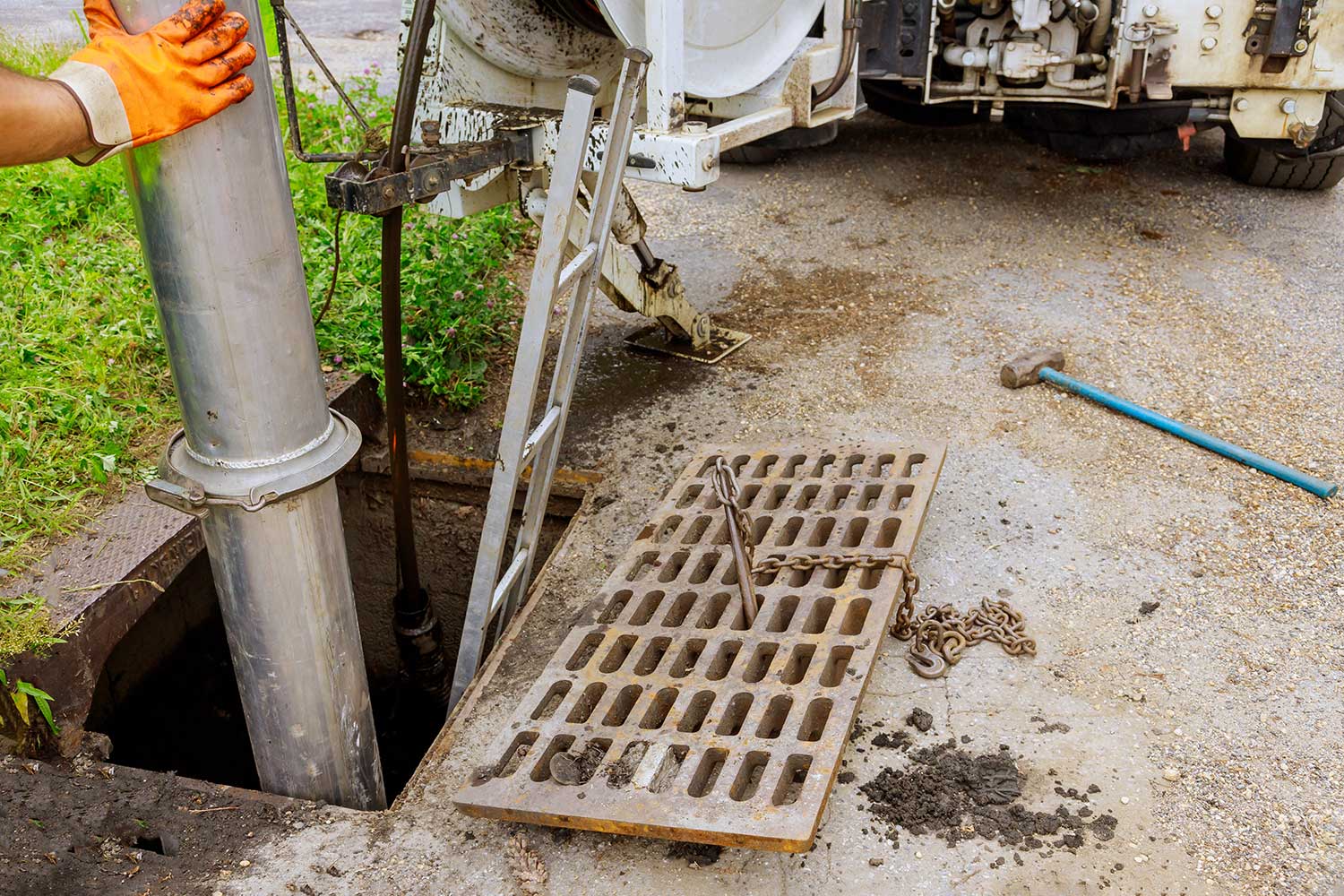Actually, septic tanks are pretty amazing. In a perfect world, household waste would float through the drain system and out into the tank. After entering the tank, the solid waste sinks to the bottom where it is broken down by enzymes and eventually dissolves in liquid, which rises to the next chamber. The liquids then overflow into the leach field, which is made up of numerous holes in pipes that disperse the waste into the earth.
Septic tanks are incredible, but they’re also delicate. A clog, an overload on the system, or an interference with the enzymes can all lead to a full tank. And nobody thinks that a septic tank full of debris is a fun place to be. Fortunately, there are ways to determine whether a septic tank needs to be pumped or is just filling to the point of fullness.
Safety Points to Remember
The truth is that homeowners shouldn’t perform traditional septic tank maintenance on their own. Because of the bacteria they hold and the fumes they emit, septic tanks can be very dangerous. A single mistake could lead to environmental problems, a dangerous infection, or even the igniting of fumes.
Fortunately, this guide will show you what to look for in the early stages of a septic tank filling up.
What Takes Place When You Have a Full Septic Tank
Because the bacteria within the tank need the waste to survive, septic tanks are made to hold a specific volume of waste. But when that waste can’t escape, it builds up in the tank and spills into the space next to the septic tank. This isn’t a pretty sight, as one might anticipate.
The homeowner must have the tank emptied and serviced when it fills. When the septic company arrives, they will locate and remove the tank cap, insert a large hose into the tank, and pump out the waste. They’ll clear any obstructions and raise the amounts of the enzymes. In actuality, the procedure is fairly intricate.
How to Determine Whether the Septic Tank Is Full
Experts are able to verify whether a tank is full. Instead, do-it-yourselfers and homeowners should search for signs. Instead of opening the lid of a potentially hazardous tank, keep an eye out for these indicators of a full septic tank.
1. Hesitant Drains
The home’s drain system terminates at the septic tank and its leach fields. The home’s drains may slow down if that tank gets full and is unable to run smoothly. Shower water may start to pool, dishwashers may not empty entirely, and toilets may fill up and then eventually empty out.
These problems with the septic tank may indicate pipe blockages, but they may also indicate that the tank is getting full.
2. Horrible Odor in the Yard
Septic tanks have a slight odor, despite what most people might not realize. Additionally, the tank cannot hold the fluids and gases that cause these odors while it is filling. Eventually, the yard might start to smell really bad.
3. Dense, Rich Grass
Liquid fertilizer, in essence, is what spills out of the second chamber into the leach fields. It has nutrients and minerals that plants can use to grow robust and beautiful. Furthermore, if the liquid is leaking out of a full tank, the nearby flowers and grass may grow into lovely, healthy plants. A leaking septic tank may be indicated by thick, green grass, or even by a concentration of dandelions or other flowers and weeds.
4. Water Puddles in the Yard
There is nowhere for the water to go when people keep filling showers, running sinks, and flushing toilets even though the tank is full. It will frequently spill directly into the yard, which may cause puddles if the water table is high or the yard doesn’t drain properly. By the time this water reaches the soil’s surface, it may be clear, but it’s actually septic runoff.
5. A rise in midges and flies
An upsurge in insect activity, such as midges or flies, may indicate a problem with the septic tank. The septic tank provides moist, organic matter—exactly what drain flies need to lay their eggs in. When there is standing water, such as when a septic tank is full or clogged, midges lay their eggs there.
6. Gurgling noises coming from the pipes
Waste should almost silently go down the drain under ideal circumstances. However, when the tank becomes clogged, air becomes trapped in front of the waste and causes it to “burp” as it passes through the pipes. These burps sound like problems with both toilets and septic tanks.
7. Restores to the House
The worst sign of a full tank is when a drain backs up into your house. This typically happens on the lower floor of the house and can be caused by a variety of factors, such as full or clogged septic tanks. Waste flushed from the floors above takes the path of least resistance—which can be a floor drain, sink, shower, or toilet—because the septic tank is unable to empty.
Septic Tank Inspection: Do It Yourself vs. Paying a Pro
The aforementioned suggestions are fairly obvious signs of a septic tank problem. These do-it-yourself suggestions aren’t infallible, though, and the tank may be filling even in the absence of those symptoms. It’s crucial to have a septic tank specialist check the tank for this reason. Once more, we advise against DIYers trying to solve their septic tank problems on their own.
The septic service will find the tank’s cap and conduct their own inspection of the tank when they arrive. They are skilled at doing this without endangering the environment or the homeowner in a safe and effective manner. Additionally, in order to promote further waste breakdown, they will introduce advantageous anaerobic bacteria to the tank. It is best to leave these tasks to the professionals.
Septic Systems are found under the ground in wastewater treatment plants, and they are usually used in areas that do not have a centralized sewer system. In order to treat the waste water that comes from residential plumbing, which is produced from kitchen drains, laundry, and bathrooms; a combination of nature itself and modern technology is used.
The most typical septic systems includes a septic tank, and a drain-field, or it may be a soil absorption field or leach field. Organic matter is digested by the septic tank and then separates it into a floatable matter (e.g., oils and grease), including the solids that come from the waste water itself.
A liquid, which is known as ‘effluent’ is discharged from the soil-based systems of the septic tank by means of a series of perforated pipes that have been buried under a leach field, or leaching chamber, and some other specialized units that are designed for slowly releasing the effluent into either the soil or to the surface of the water.
There are some alternative systems which use pumps and sometimes gravity, which helps the effluent to trickle out of the septic tank and through the sand and organic matter, such as sawdust and/ or peat. And constructed wetlands, even different media are sometimes used in removing or neutralizing pollutants such as pathogens that can cause diseases, nitrogen, phosphorus, are among many more contaminants that may be present.
There are a few alternative systems that have been designed for evaporating waste water and/ or disinfecting it prior to discharging it into the soil, or to the surface of the waters.
The specifics of how the typical septic system works:
- The water that runs back out of your home goes through a drainage pipe, this is the main drainage from your home that takes the used water to a septic tank.
- The septic tank that the used water goes to is sealed in a water tight container that is buried under the ground and is made from either concrete, fiber-glass, or polyethylene.The job of the septic tank is to contain the waste water until the solids settle to the bottom of the tank, forming sludge and the oil, grease, and other liquids float to the surface, referred to as scum.The septic tank consists of different compartments, having a t-shaped outlet to prevent any sludge and/or scum from seeping out of the tank (keeps it from getting to the drain-field area).
- Once the waste water has had enough time to settle it along with the effluent, it is then released into the drain-field.
- The drain-field has been constructed and excavated in soil that is unsaturated, and in a field that is shallow, and has been covered up. Next, the pretreated waste water gets released through the piping onto a porous surface, allowing the waste water to be filtered from the soil.The waste water is then accepted, treated and dispersed by the soil and then percolates on through the soil, eventually, being released into the ground water.If the drain-field is ever overloaded, having more liquid than it can handle, it would cause it to flood and the sewage could flow up to the ground surface and/ or create a back-up in the toilets and sinks.
- Finally, as the waste water is percolating in the soil the harmful coliform bacteria, nutrients, and viruses, are naturally removed. The coliform bacteria are bacteria that predominantly inhabits on the inside of the human intestines, they can also inhabit on the inside of different warm blooded animals. This indicates that there is combination in the human fecal.
Does your home use a septic system?
You probably will know if you have a septic system. Generally when you are buying a home you will find out what type of solid waste disposal system the house has installed. If you aren’t sure, read the clues below to know if you have city or septic waste disposal.
However, for those who do not yet know, below are some definite signs that you do:
- Your water comes from a well.
- There is no water meter to your home.
- There will be “no-charge” showing up on either your water bill or your property taxes.
- If any of your neighbors have septic tanks, it is very likely that you do, too.
After finding out that you are using a septic system, you will be able to locate it by doing the follow things below:
- You can look over the ‘as built’ drawing, which you can usually get from your local court house.
- Check to see if your yards have any lids a top of the ground and/or manhole covers.
- Contact a professional to assist you in finding it.
*Pay Attention To The Signs Of Septic Tank Failures!*
If you should notice any of the following you should contact a septic tank professional right away:
- Smell coming from your septic tank is not always going to be the first sign that it is malfunctioning.
- There is waste water backing up in the household drains.
- Dry weather or not, if you notice spongy, bright green grass on and around the drain-field.
- There is muddy soil or water gathering around the septic system, or it may be in your basement. There is a strong stinky smell coming from around your septic tank, and the drain-field area.
Septic Tank Service Arizona
Let A-American Septic Service help you find the right septic system for your application. Call 602-254-5448 today to discuss which type of system will work best for your application and help with septic tank design & installation.[/vc_column_text][/vc_column][/vc_row]







